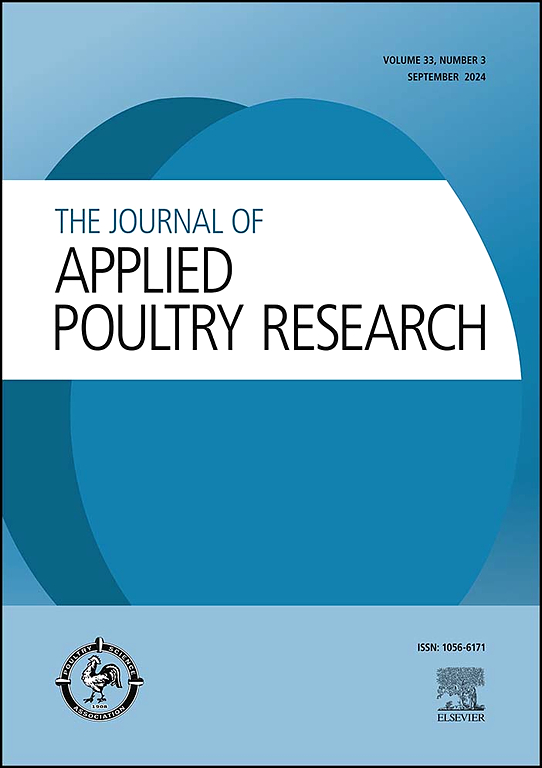Evaluating microbiome patterns, microbial species, and leg health associated with reused litter in a commercial broiler barn
IF 2
3区 农林科学
Q2 AGRICULTURE, DAIRY & ANIMAL SCIENCE
引用次数: 0
Abstract
Poultry litter amendments are commonly used to mitigate ammonia levels by binding and reducing ammonia volatilization in poultry housing, but there are concerns that litter amendments may impact broiler health. The goal of our study is to characterize the effect of an organic-certified diatomaceous earth litter amendment on the microbial content of the litter, and the gastrointestinal microbiome and leg health of fast-growing broilers. The study was carried out over a 2-yr period involving 5 consecutive flocks housed in a barn, where one half of the barn received the litter amendment while the other half served as a control. Key health indicators such as gastrointestinal microbiome diversity, and leg health were monitored. The findings suggest that the organic litter amendment, while not significantly altering the bacterial counts in the litter, may offer benefits in improving broiler wellbeing. This is evidenced by differences in footpad dermatitis and hock burn scores between the treated and control groups, highlighting the potential of such amendments not only in managing ammonia levels but also in promoting animal health. This study provides valuable insights into the applied implications of using an organic diatomaceous earth amendment in a poultry facility, indicating a positive impact on bird welfare without altering the microbial balance within the litter.
评估商品肉鸡饲养场中与重复使用的废弃物有关的微生物群模式、微生物种类和腿部健康状况
家禽粪便改良剂通常用于通过结合和减少家禽饲养中的氨挥发来降低氨含量,但有人担心粪便改良剂可能会影响肉鸡的健康。我们的研究目标是确定有机认证硅藻土废弃物添加剂对废弃物中微生物含量、快速生长肉鸡的胃肠道微生物组和腿部健康的影响。这项研究为期 2 年,在一个鸡舍中连续饲养了 5 群肉鸡,其中一半鸡舍使用了硅藻土垫料,另一半鸡舍作为对照。监测的主要健康指标包括胃肠道微生物群多样性和腿部健康。研究结果表明,有机菌落改良剂虽然不会明显改变菌落中的细菌数量,但可以改善肉鸡的健康状况。处理组和对照组之间在脚垫皮炎和跗关节烧伤评分上的差异证明了这一点,突出了此类添加剂不仅在管理氨水平方面,而且在促进动物健康方面的潜力。这项研究为在家禽设施中使用有机硅藻土添加剂的应用意义提供了宝贵的见解,表明在不改变粪便中微生物平衡的情况下对禽类福利产生了积极影响。
本文章由计算机程序翻译,如有差异,请以英文原文为准。
求助全文
约1分钟内获得全文
求助全文
来源期刊

Journal of Applied Poultry Research
农林科学-奶制品与动物科学
CiteScore
4.10
自引率
10.50%
发文量
80
审稿时长
104 days
期刊介绍:
The Journal of Applied Poultry Research (JAPR) publishes original research reports, field reports, and reviews on breeding, hatching, health and disease, layer management, meat bird processing and products, meat bird management, microbiology, food safety, nutrition, environment, sanitation, welfare, and economics. As of January 2020, JAPR will become an Open Access journal with no subscription charges, meaning authors who publish here can make their research immediately, permanently, and freely accessible worldwide while retaining copyright to their work. Papers submitted for publication after October 1, 2019 will be published as Open Access papers.
The readers of JAPR are in education, extension, industry, and government, including research, teaching, administration, veterinary medicine, management, production, quality assurance, product development, and technical services. Nutritionists, breeder flock supervisors, production managers, microbiologists, laboratory personnel, food safety and sanitation managers, poultry processing managers, feed manufacturers, and egg producers use JAPR to keep up with current applied poultry research.
 求助内容:
求助内容: 应助结果提醒方式:
应助结果提醒方式:


